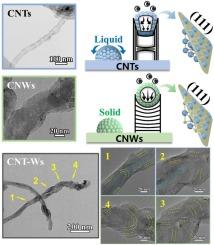Precision synthesis and growth kinetics of one-dimensional carbon nanostructures by Co-based catalysts
IF 5.5
2区 材料科学
Q1 MATERIALS SCIENCE, CHARACTERIZATION & TESTING
引用次数: 0
Abstract
Microstructures of one-dimensional carbon nanomaterials directly govern their properties and applications. Thus, precise structural control remains a focus goal of carbon-nanomaterial research. Transition-metal catalysts induce the growth of one-dimensional carbon nanomaterials via the adsorption and precipitation of carbon atoms. However, how oxygen doping in the catalyst affects the resulting nanostructures remains incompletely understood. In this work, Co-based catalysts were exposed to either a carbon-only or an oxygen-containing atmosphere, leading to the synthesis of two one-dimensional carbon nanomaterials with distinctly different microstructures. Bamboo-like carbon nanotubes (CNTs) were synthesized in the carbon-only atmosphere, whereas solid wire-like carbon nanowires (CNWs) were obtained in the oxygen-containing atmosphere. Compared CNTs and CNWs, the graphite layers within the carbon nanomaterials exhibit different stacking orientations. Energy-dispersive X-ray spectroscopy (EDS), X-ray photoelectron spectroscopy (XPS), X-ray diffraction (XRD), and selected-area electron diffraction (SAED) were employed to analyze the elemental distribution and crystal structure of the Co-based catalysts. The CoO phase was confirmed to exist within the catalysts of CNWs, which redirected the microstructures of the one-dimensional carbon nanomaterials by modulating the phase stability and lattice parameters. Therefore, this work discovers a new way for altering the microstructure of one-dimensional carbon nanomaterials.

基于co基催化剂的一维碳纳米结构的精密合成及其生长动力学
一维碳纳米材料的微观结构直接决定着其性能和应用。因此,精确的结构控制仍然是碳纳米材料研究的重点目标。过渡金属催化剂通过碳原子的吸附和沉淀诱导一维碳纳米材料的生长。然而,催化剂中的氧掺杂如何影响所得到的纳米结构仍然不完全清楚。在这项工作中,将co基催化剂暴露在纯碳或含氧气氛中,从而合成了两种微观结构截然不同的一维碳纳米材料。竹状碳纳米管(CNTs)是在纯碳气氛下合成的,而固体线状碳纳米管(CNWs)是在含氧气氛下合成的。与碳纳米管和碳纳米管相比,碳纳米材料中的石墨层表现出不同的堆叠方向。利用能量色散x射线能谱(EDS)、x射线光电子能谱(XPS)、x射线衍射(XRD)和选择区域电子衍射(SAED)分析了co基催化剂的元素分布和晶体结构。碳纳米管催化剂中存在CoO相,通过调节碳纳米管的相稳定性和晶格参数,改变了碳纳米管的微观结构。因此,本研究发现了一种改变一维碳纳米材料微观结构的新方法。
本文章由计算机程序翻译,如有差异,请以英文原文为准。
求助全文
约1分钟内获得全文
求助全文
来源期刊

Materials Characterization
工程技术-材料科学:表征与测试
CiteScore
7.60
自引率
8.50%
发文量
746
审稿时长
36 days
期刊介绍:
Materials Characterization features original articles and state-of-the-art reviews on theoretical and practical aspects of the structure and behaviour of materials.
The Journal focuses on all characterization techniques, including all forms of microscopy (light, electron, acoustic, etc.,) and analysis (especially microanalysis and surface analytical techniques). Developments in both this wide range of techniques and their application to the quantification of the microstructure of materials are essential facets of the Journal.
The Journal provides the Materials Scientist/Engineer with up-to-date information on many types of materials with an underlying theme of explaining the behavior of materials using novel approaches. Materials covered by the journal include:
Metals & Alloys
Ceramics
Nanomaterials
Biomedical materials
Optical materials
Composites
Natural Materials.
 求助内容:
求助内容: 应助结果提醒方式:
应助结果提醒方式:


